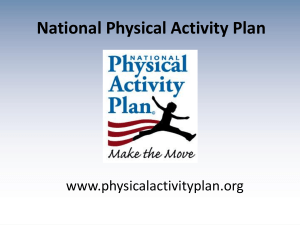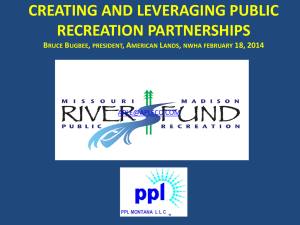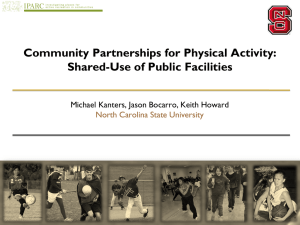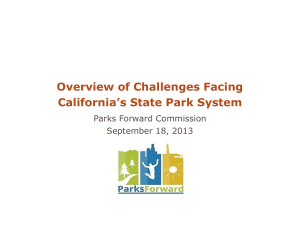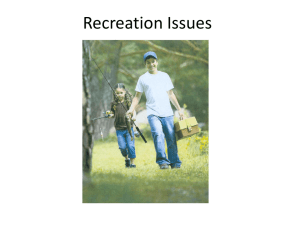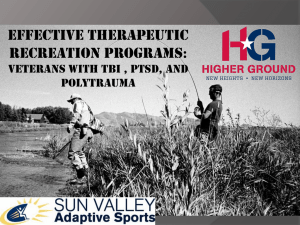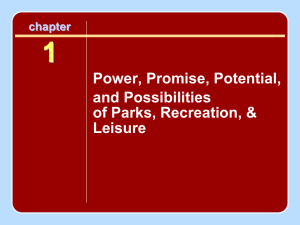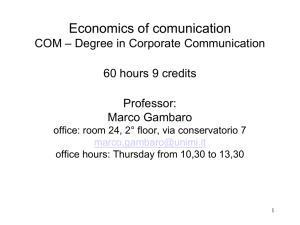Parks and Recreation Community Facilities Operations Plan
advertisement
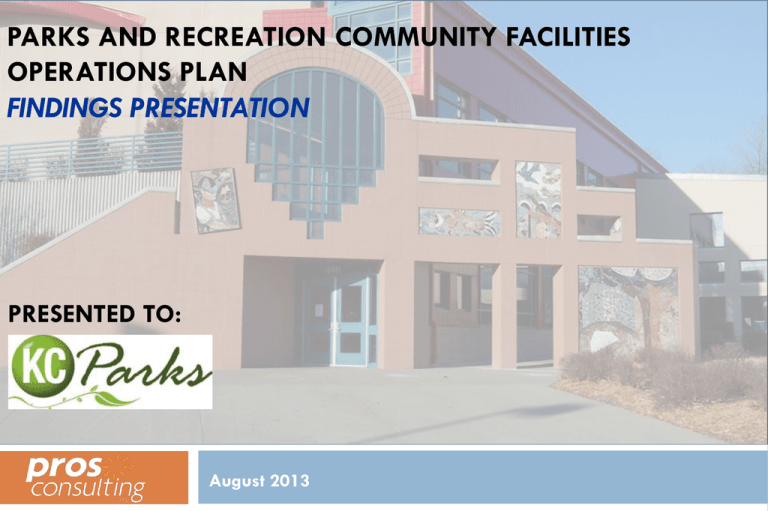
PARKS AND RECREATION COMMUNITY FACILITIES OPERATIONS PLAN FINDINGS PRESENTATION PRESENTED TO: August 2013 Agenda Project Planning Process Community Input Demographics Program & Facility Analysis Individual Community Center Market Analysis for the Center Region Operation & Governance Assessment Employee Assessment Operational & Business Analysis Recommendations Project Planning Process Project Planning Process Vision and Mission Demographic, Trends & Market Analysis Community Center Assessment Public Input Organizational Analysis & Service Classification Operational & Business Analysis Financial & Operations Strategy Assessment and Operating Plan Community Input PROS Consulting conducted twenty-seven (27) focus groups along with nine (9) public forums at eight of the nine community centers (Southeast and Marlborough held together) Consultants Observations from Community Input The Department is more of a recreation facility provider than a direct program and facility provider Parks are more recognized and appreciated than recreation services by the community The road signage to get to parks and recreation facilities is minimal which doesn’t help the community to understand the location and opportunities that exists for recreation services Many of the community centers have excess capacity of program spaces that could be used in a more efficient and productive manner It appears that the majority of the community centers do relatively the same types of programs Consultants Observations from Community Input Program standards are not consistently applied across the system The organizational structure of the Recreation Division is center based versus system based The cost recovery rates desired for facilities and programs are not well defined Many of the fitness rooms in recreation centers are too small to garner the level of users to achieve a high level of success and use More open multipurpose space needs to be considered and reevaluated in the recreation centers Consultants Observations from Community Input Most of the gym floors are in need of refurbishing Customer service standards are inconsistently applied across the system True cost of services is not being tracked by staff for services provided or facilities provided to determine unit costs to provide the services Outdoor pools are very limited in size to support a variety of aquatic experiences Consultants Observations from Community Input Classification of programs as core essential, important and value added needs to be addressed Performance measure tracking is missing at most of the community centers to demonstrate outcomes desired Youth use of fitness equipment is not allowed and the Department should consider the YMCA model for access with set times of the day with adult supervision present in the room Staff in the field and the community desire to see key recreation administrators more in the field to share their issues with them to help improve their programs and services Consultants Observations from Community Input Concession services and vending is limited in most centers Stepped up marketing of services is desired from the community throughout the city Hours of operation are a concern of many people and they would like to see hours adjusted where possible to meet their needs Many of the Community Centers serve a specific population and could be more multi-generational Demographics Central East Kansas City Decreasing Population Fairly balanced age segment Central East Kansas City Very diverse Growing Hispanic/Latino population Central East Kansas City Gradual income growth Significantly lower than State and National averages Program and Facility Analysis Central East 10 Minute Drive Time Map The centers in the Central East region are closely clustered and cover a small and virtually identical target audience Each center is within a 10 minute driving distance of the other and this translates into a high level of service duplication as well as low cost recovery in the area Central East Level of Service The Central East Region has a population of 142,934 which is being served by approximately 84,171 square feet i.e. 0.59 s.f. /person. This translates to a less than recommended level of service and expansion of existing recreation centers along with new recreation centers would be required to address the shortfall. Individual Community Center Market Analysis for the Central Region Westport Roanoke Community Center Extremely high young adult/ family (18-34) age segment Population is skewed towards White Alone, with over 60% of the population Westport Roanoke Community Center ACTION PLAN With 40% of the age segment being 18-34, it would benefit the center to offer continued education programs and affordable child care to accommodate young working parents Offering additional programming for young children that are in pre-school and elementary school should be considered With many of the household being start-up households, it would be good to offer low cost / affordable programming Tony Aguirre Community Center A high Hispanic origin located in the 1 mile radius (36%) but drops to 19% in the 2 mile radius The population is skewed towards the 18-34 age segment in both radii Tony Aguirre Community Center ACTION PLAN Offer programming that cater to the high ethnic diversity found in the community Based on tapestry information, it would benefit the center to create more special events that bring the community together Offer low cost childcare and programming for youth children in preschool and elementary school Gregg Klice Community Center Gregg Klice echoes Tony Aguirre with a high Hispanic origin and a skewed age segment (18-34) in both radii Median household income is higher in the 1 mile radius ($37,354) compared to the 2 mile radius ($27,317) Gregg Klice Community Center ACTION PLAN Offer programming that cater to the high ethnic diversity found in the community Based on tapestry information, it would benefit the center to offer trips, social events, and trendy exercise classes for young adults Offer low cost childcare and programming for youth children in preschool and elementary school Garrison Community Center Age segment is skewed towards the 18-34 age segment (about 35%) with a small senior population around 15%. White and Black Alone each make up about 40% of the population Garrison Community Center ACTION PLAN Offer programming that cater to the high ethnic diversity found in the community Offer programming for family’s to enjoy together such as trips to the zoo and theme parks Offer low cost childcare and programming for youth children in preschool and elementary school Operation and Governance Assessment Governance Analysis & Classification of Services Service Classification Descriptions CRITERIA TO CORE ESSENTIAL PUBLIC IMPORTANT PUBLIC CONSIDER SERVICES SERVICES High Public Expectation High Public Expectation VALUE ADDED SERVICES Public interest or developmental importance as well as mandated by law High Individual and Interest Group Expectation and is mission aligned Free, Nominal or Fee Financial sustainability Tailored to Public Needs __ Requires Public Funding Benefits – i.e. health, safety, and protection of a valuable asset. Competition in the Substantial Public Benefit (negative consequence if not provided) Limited or No Alternative market Providers Access Open Access by All Fees Cover Some Direct Fees Cover Most Direct and Costs Indirect Costs __ __ Requires a Balance of Public Funding and a Some Public Funding as Cost Recovery Target Appropriate Public and Individual Benefit Primarily Individual Benefit Alternative Providers Unable to Meet Demand Alternative Providers or Need Readily Available Open Access / Limited Limited Access to Specific Access to Specific Users Users KCMO PARKS AND RECREATION DEPARTMENT CLASSIFICATIONS Typical Core Essential Programs recover 0-20% of the operational costs: Open swim Teen swim Community festivals Fitness center drop-in Outdoor adventure programs First Friday programs Senior classes Therapeutic programs Family programs Drop in basketball for exercise KCMO PARKS AND RECREATION DEPARTMENT CLASSIFICATIONS Important Services Programs recover 20-80% of the operational costs: Preschool swim lessons Children swim lessons Senior aquatic programs Life skill classes Preschool classes Parent and child classes Summer day camps T-ball program Youth team basketball Youth team basketball Youth boxing Silver sneakers for seniors Biddy basketball Soccer leagues Sports Clinics for kids Youth tennis lessons Arts programs Performing arts programs Youth hockey programs KCMO PARKS AND RECREATION DEPARTMENT CLASSIFICATIONS Valued Added Services recovery 80-100% of their operational costs: Aqua aerobics Aqua fitness classes WSI instruction Lap swim Specialty classes Private swim lessons Martial arts Archery Personal training Dog obedience classes Yoga Zumba Computer Classes Aerobics Volleyball leagues Basketball leagues for adults Pickle Ball Leagues Private rentals of community space Dodge ball Piano Lessons Tennis lessons Senior trips Hockey tournaments Employee Assessment Over 30 Center Directors and Assistant Center Directors participated in this survey which serves as a good yardstick to assess current employee sentiment at a point in time. These surveys were conducted in AprilMay 2013. Malcom Baldridge Model used Leadership Strategic Planning Customer and Market Focus Measurement, Analysis, & Knowledge Management Workforce Focus Process Management Operational and Business Analysis Operational and Business Analysis Recommendations HOW ARE THE OPERATIONAL AREAS STRUCTURED? Recommendation – Recreation Services should be divided into three districts with a manager over each District with city wide services DOES THE CURRENT ORGANIZATIONAL STRUCTURE LEND ITSELF TO MAXIMIZING REVENUES AND CONTROLLING EXPENDITURES? Recommendation - Redesign the recreation division into regional districts and city-wide services to maximize the functionality and revenue capability of the division Operational and Business Analysis Recommendations DETERMINE THE RELIABILITY AND INTEGRITY OF FINANCIAL AND OPERATIONAL INFORMATION Recommendation - Acquire the modules needed for tracking cost of service from RecTrac DETERMINE THE EFFECTIVENESS, EFFICIENCY AND ECONOMY OF THE OPERATIONS Recommendation - Develop business plans for each recreation center and or attraction Operational and Business Analysis Recommendations DETERMINE if OPERATIONS ARE SUSTAINABLE Recommendation - Establish an updated pricing policy and cost recovery goal for the recreation division as a whole and for each recreation site and core program area DETERMINE IF ASSETS ARE SAFEGUARDED Recommendation - Develop a cost benefit assessment for each improvement planned. Prioritize these improvements to achieve the financial goals desired for the Department and the Division. Operational and Business Analysis Recommendations DETERMINE IF SAFETY AND RISK MANAGEMENT GOALS ARE IN PLACE Recommendation - Develop a customer and staff safety plan for each site and implement changes required DETERMINE THAT THE OPERATIONS ARE IN COMPLIANCE WITH APPROPRIATE LAWS, REGULATIONS AND CONTRACTS Develop a review schedule for each contract and agreement in the system and update accordingly Key Recommendations Key Preliminary Recommended Actions Reorganize the Recreation Division into three functional Districts that will be responsible for three or four community centers Program by regional district versus focusing on each community center as its own standalone center Add additional space to smaller community centers to create more program space and increase the operating revenues from the site Reopen the pool at Line Creek Key Preliminary Recommended Actions Eliminate duplication of programs in each District unless the program demand requires it and develop specific themes for each community center Active Seniors and Family Programing (senior programs, senior wellness, family activities) Fine Arts and Performing Arts (fine arts, performing arts, music, dance) Sports, Fitness and Wellness (sports leagues, fitness and wellness programs, clinics and workshops) Aquatics and Fitness (aquatic programs, aquatic fitness, swim teams, fitness and wellness classes) Life Skill Center (computer skills, cooking, gardening, healthy eating, reading, English classes, neighborhood focus) Ice Center (ice hockey, figure skating, clinics, tournaments) Key Preliminary Recommended Actions Add additional core programs to broaden the program offerings and user base to include: Before school and after school programs Family programs Senior programs Wellness classes Arts programs Aquatics programs Adult sports Outdoor recreation Key Preliminary Recommended Actions Develop an updated pricing policy and philosophy based on core essential, important and value added programs and create specific cost recovery goals for each community center and core program area. Develop earned income programs for each community center to increase revenues for each site. Develop a business development office for the Recreation Division to generate more revenue and support a stronger marketing effort Develop performance measures that focus on accountability, efficiency and revenue production Key Preliminary Recommended Actions Develop a program plan for aquatics to strengthen the programs offered. Develop a stronger volunteer program to help staff Redevelop city-wide programs in adult sports, some youth sports, Teen services (ages 12-17), aquatics, fitness, preschool programs (3-6 with parents), senior services, arts and dance, outdoor recreation, after school programs, and ice related programs. Develop more contractor related classes with a 60/40 split in revenue back to the Department. Key Preliminary Recommended Actions Develop consistency in how program standards are delivered for youth and adults. Develop consistency in community center cleanliness standards. Develop consistency in how community centers are staffed based on prime time and non-prime times. Develop consistency in recreation staff training and development as it applies to programming, pricing, marketing, communication, customer service, RecTrac management and performance tracking. Develop employee work plans and employee work teams to implement the goals and objectives listed in the Recreation Plan. Key Preliminary Recommended Actions Design recreation facilities to produce revenue and create larger spaces for fitness, aquatics, gyms, walking tracks and wellness related rooms. Increase partnerships with local schools, not-for-profits, health care providers, and private businesses in delivery of programs to the community. Develop more teen programs offering an array of programs that might include social recreation, music, tutoring, mentoring and non-sports activities for both girls and boys. Key Preliminary Recommended Actions Develop adventure programs for youth and adults in kayaking, mountain biking, rock climbing, scuba diving, skateboarding, and paddle boarding. Increase the program development for youth and adults in swimming instruction and recreational swimming for youth. Develop a second sheet of ice at the Line Creek Community Center to increase leagues and tournaments to help support the facility to become more self-supporting. Key Preliminary Recommended Actions Complete a comprehensive marketing plan and program business plan that gives consideration and identifies potential promotional strategies for each of the following: Networking-go where the market is; Direct marketing-brochures and flyers; Advertising-print media, directories; Training programs-to increase awareness; Write articles-give advice, become known as the expert; Direct/Personal selling; Publicity/press releases; Step up social media; PARKS AND RECREATION COMMUNITY FACILITIES OPERATIONS PLAN FINDINGS PRESENTATION QUESTIONS?
